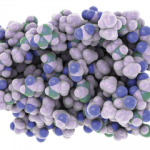ATLANTA—When it comes to identifying reliable biomarkers that can predict worsening illness or help point to proper treatment, it’s hard to imagine a more vexing disease than systemic lupus erythematosus (SLE), said Jill P. Buyon, MD, director of the Lupus Center at New York University Langone Medical Center, in the 2019 ACR/ARP Annual Meeting session Emerging Biomarkers: Precision Medicine in Lupus.
The diversity of people who get the disease and how the disease presents itself are huge challenges for science to wrap its arms around.
“To make that even more challenging for you, we’ve just added a third major set of criteria, the ACR/EULAR criteria,” said Dr. Buyon.
To drive home the point, she offered this statistic: Taking all possible combinations of classification criteria into account results in 333 types of lupus patients, each with a different phenotypic subset, she said.
The Search for Biomarkers
But the search for biomarkers—a slate that already includes anti-double stranded DNA antibodies, serum complement levels and anti-Ro and anti-La antibodies—continues. And Dr. Buyon is optimistic about what the future holds. It is, she said, “amazing how we are harnessing technology to understand lupus and develop biomarkers.”
“The landscape has really changed,” she said. “And that is the landscape that allows us to do immune profiling or immune cell
profiling—and these represent huge technological advances in multidimensional analysis of immune cells to allow deeper understanding of disease pathogenesis and heterogeneity and the discovery of novel biomarkers.”
Cell-bound complement activation products (CB-CAPs), she said, are perhaps more reliable biomarkers for tracking lupus than soluble complement proteins C3 and C4. Although soluble complement activation products are subjected to hydrolysis in circulation or tissue fluids, CB-CAPs attach covalently to circulating cells and can remain on their surfaces for the lifespans of the cells, Dr. Buyon said.
Research has found that CB-CAPs are associated with active SLE, with prospective validation and confirmation of this relationship still needed, she said.1 And it is the only biomarker that can simply be ordered, Dr. Buyon said.
In a study of patients with active lupus, an SLE Disease Activity Index (SLEDAI) score and high levels of CB-CAPs, two types of CB-CAPs—EC4d and EC3d—had independent and additive values in tracking disease.2
 Dr. Buyon described a state of both excitement and confusion when it comes to the potential value of interferon-α (IFNα) as a biomarker. Elevated levels of IFN in SLE patients who are in remission have been found to predict flares. But in trials of rontalizumab, no difference was found in disease activity scores between those with high and low IFNα levels.3
Dr. Buyon described a state of both excitement and confusion when it comes to the potential value of interferon-α (IFNα) as a biomarker. Elevated levels of IFN in SLE patients who are in remission have been found to predict flares. But in trials of rontalizumab, no difference was found in disease activity scores between those with high and low IFNα levels.3
“I still feel there is a lot of confusion as to who is the appropriate patient to be on this drug,” Dr. Buyon said.
Recent findings on anifrolumab also presented a complicated picture. Overall, the treatment arm outperformed placebo, with identical efficacy in patients with high IFN and low IFN. But the high-IFN group saw a much lower placebo effect, leading to a demonstration of efficacy, Dr. Buyon said.4
Molecular Fingerprints
A study of 158 children with lupus, followed for about four years, suggests the tantalizing possibility of establishing molecular fingerprints that could eventually be used to guide therapy. Researchers found certain genes were less expressed and some more heavily expressed. When they grouped these genes, they found a high expression of interferon response in most, a plasmablast signature in about a quarter of the patients and a neutrophil response in about half. This led to observations related to their clinical picture: For example, the sicker a patient was, the more robust plasmablast signature they tended to have.5
The possibilities brought to mind by these data are enticing, Dr. Buyon said.
“You can begin to now say, ‘I’m going to do genotyping, I’m going to do blood modules, and now I can pick out the treatment that is precise for that patient,’” she said. “Are we there yet? You’re going to see that in the next few years—I really do think so.”
New Clues Regarding Flare
In other recent work, researchers have uncovered new clues regarding flare. A longitudinal study of SLE patients looking at 52 soluble mediators found that T helper 1 and 2 cells (Th1 and Th2), interferon and tumor necrosis factor were all associated with flare in SLE patients, and transforming growth factor-ß (TGFß) and interleukin (IL) 10 seemed to be protective and associated with no flare.6,7
The Biomarkers of Lupus Disease (BOLD) study involved patients who were doing poorly, but not severely so, before enrollment. Their drugs were stopped, they were given steroids and improved, and blood was drawn in search of flare predictors.8
Among patients who flared early, elevated interferon was predictive of this early flare. These patients also had elevated inflammatory markers and suppressed T cells. In the late flare group, researchers saw suppressed inflammation, a decreased monocyte signature and slightly elevated T cells.
Compared to the late flare group, the early flare group also had significantly higher frequencies of activated CD11b-positive neutrophils and monocytes, and activated CD86-naive B cells.
Such findings, Dr. Buyon said, are “beginning to tell us there are differences in not only who’s going to flare, but when somebody is going to flare.”
Predicting Disease Course in LN
Other findings have been enlightening in predicting disease course in lupus nephritis (LN). For example, serum albumin levels at 12 months after biopsy can predict adverse renal outcomes at four years.9
In a multi-center study Dr. Buyon helped lead, researchers used single-cell RNA sequencing to assess renal biopsies from patients with LN.10
“We were able to show that the tubular cells from patients with lupus nephritis expressed higher levels of interferon response genes than normal, healthy kidneys. And not only that, it actually predicted … non-response vs. response at six months,” she said. “What’s really remarkable to us is that the keratinocytes from these patients also expressed interferon genes and may be a helpful adjunct in looking at what’s going on in the kidney.”
This study, she said, is a sign of the power of technology, which is part of the reason for her optimism in finding greatly improved lupus biomarkers in the not-too-distant future.
“The holy grail is that biomarkers will fill certain promises,” she said. “They’ll aid the clinician in managing the patient, they’ll help you sort out phenotypic heterogeneity. It’ll inform you a little bit about pathogenesis and provide targets for therapy.”
Thomas R. Collins is a freelance writer living in South Florida.
References
- Ramsey-Goldman R, Li J, Dervieux T, Alexander RV. Cell-bound complement activation products in SLE. Lupus Sci Med. 2017 Aug 21;4(1):e000236.
- Buyon J, Furie R, Putterman C, et al. Reduction in erythrocyte-bound complement activation products and titres of anti-C1q antibodies associate with clinical improvement in systemic lupus erythematosus. Lupus Sci Med. 2016 Sep 30;3(1):e000165.
- Kalunian KC, Merrill JT, Maciuca R, et al. A phase II study of the efficacy and safety of rontalizumab (rhuMAb interferon-α) in patients with systemic lupus erythematosus (ROSE). Ann Rheum Dis. 2016 Jan;75(1):196–202.
- Furie R, Khamashta M, Merrill JT, et al. Anifrolumab, an anti-interferon-α receptor monoclonal antibody, in moderate-to-severe systemic lupus erythematosus. Arthritis Rheumatol. 2017 Feb;69(2):376–386.
- Banchereau R, Hong S, Cantarel B, et al. Personalized immunomonitoring uncovers molecular networks that stratify lupus patients. Cell. 2016 Apr 21;165(3):551–565.
- Munroe ME, Vista ES, Guthridge JM, et al. Proinflammatory adaptive cytokine and shed tumor necrosis factor receptor levels are elevated preceding systemic lupus erythematosus disease flare. Arthritis Rheumatol. 2014 Jul;66(7):1888–1899.
- Munroe ME, Vista ES, Merrill JT, et al. Pathways of impending disease flare in African-American systemic lupus erythematosus patients. J Autoimmun. 2017 Mar;78:70–78.
- Lu R, Guthridge JM, Chen H, et al. Immunologic findings precede rapid lupus flare after transient steroid therapy. Sci Rep. 2019 Jun 13;9(1):8590.
- Domingues V, Levinson BA, Bornkamp N, et al. Serum albumin at 1 year predicts long-term renal outcome in lupus nephritis. Lupus Sci Med. 2018 Sep 4;5(1):e000271.
- Der E, Suryawanshi H, Morozov P, et al. Tubular cell and keratinocyte single-cell transcriptomics applied to lupus nephritis reveal type I IFN and fibrosis relevant pathways. Nat Immunol. 2019 Jul;20(7):915–927.

